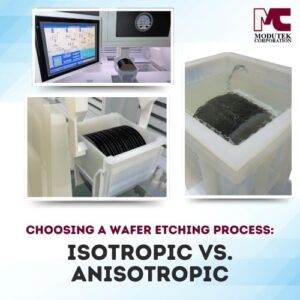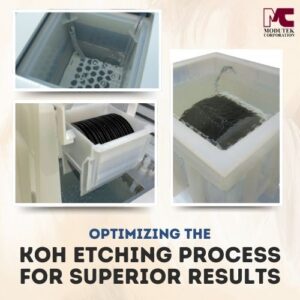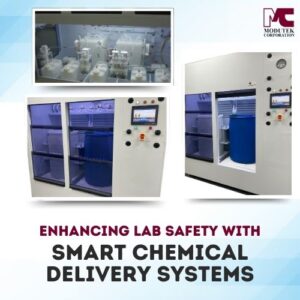![]() When wafer cleaning immediately prior to diffusion is effective, semiconductor manufacturing output is of high quality and the defect rate is reduced. A major pre-occupation of pre-diffusion cleaning is the removal of microscopic particles from the surface of the silicon wafer. Particles can prevent even diffusion and may themselves be diffused into the silicon, causing defects.
When wafer cleaning immediately prior to diffusion is effective, semiconductor manufacturing output is of high quality and the defect rate is reduced. A major pre-occupation of pre-diffusion cleaning is the removal of microscopic particles from the surface of the silicon wafer. Particles can prevent even diffusion and may themselves be diffused into the silicon, causing defects.
Silicon wafer cleaning can be carried out in chemical baths or with megasonic cleaning systems. Several cleaning steps using different processes are sometimes required to get a specific level of cleanliness. The goal is to obtain wafers free from metallic or organic contamination and with as few surface particles as possible. As silicon microstructures are designed with smaller elements and with a higher component density, adequate wafer cleaning becomes more and more critical.
RCA Clean Uses Two Steps to Remove Organic and Metallic Contamination
RCA clean uses ammonium hydroxide, hydrogen peroxide and hydrochloric acid to remove surface contaminants from the silicon wafer. In the Standard Clean 1 (SC1) process, the wafers are placed in a mixture of ammonium hydroxide and hydrogen peroxide. The corrosive mixture removes organic matter but may leave metal ions behind.
In the Standard Clean 2 (SC2) process, the remaining metallic traces are removed by immersing the wafers in a mixture of hydrochloric acid and hydrogen peroxide. At the end of the RCA wafer cleaning process, organic and metallic contamination has been removed while as many remaining particles as possible are rinsed away as well.
Piranha Clean Removes Heavy Organic Contamination
When wafers are heavily contaminated with organic materials such as photo resist, the Piranha process cleans more quickly than RCA clean. The wafers are immersed in a mixture of sulfuric acid and hydrogen peroxide and the mixture may be heated to speed up the reaction. The piranha clean process hydroxilates the wafer surface, making it hydrophilic. This affinity for water is sometimes a useful feature for additional cleaning measures.
Megasonic Cleaning Removes Contaminants and Particles
Megasonic cleaning avoids the use of corrosive chemicals and is especially effective for dislodging microscopic particles from the wafer surface. The Megasonic process works by generating high-frequency sound waves in the cleaning bath. An ultrasonic generator produces the high-frequency electronic signal and a transducer converts the signal into sound waves that travel through the cleaning solution. The sound waves create tiny cavitation bubbles that produce a scrubbing action against the wafer surface. The action of the bubbles cleans the wafer.
Microscopic contaminating particles adhere to the wafer and are difficult to remove. With integrated circuits featuring increasingly smaller geometries, even the tiniest particles can cause defects. Megasonic silicon wafer cleaning operates in the frequency range near or above 1 MHz and the cavitation bubbles agitate the cleaning solution at the operating frequency. Such agitation breaks the bond holding the particle on the wafer surface and the floating particles can be rinsed away.
Modutek Wet Bench Equipment Supports Pre-Diffusion Cleaning Methods
RCA, Piranha and Megasonic cleans are commonly used in pre-diffusion clean, but each fabrication facility optimizes for its own sequence of semiconductor manufacturing processes. A production line may use one or several cleaning methods, and may have special requirements for production parameters such as size, temperature or timing.
Modutek designs and builds its own complete line of wet bench equipment and can advise customers on choosing the best processing stations for their applications. Ideal solutions often require extensive customization to optimize yield and reduce costs to a minimum. Modutek can provide custom solutions including pre-diffusion cleans, and can design new equipment for integration into the customer’s manufacturing line to meet specific wafer processing requirements.




